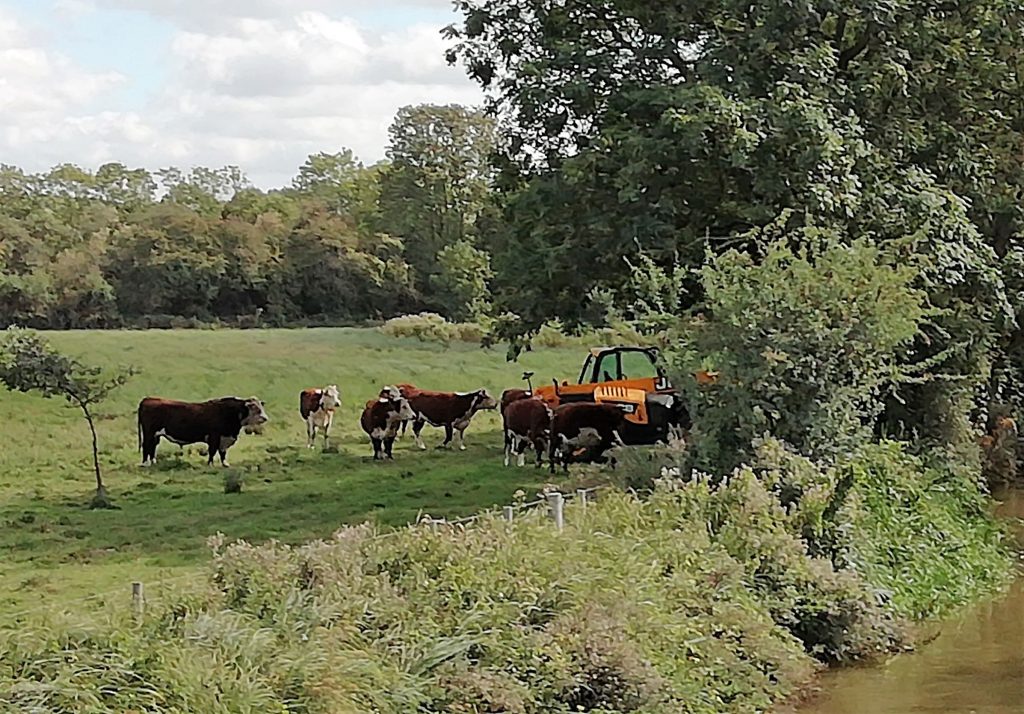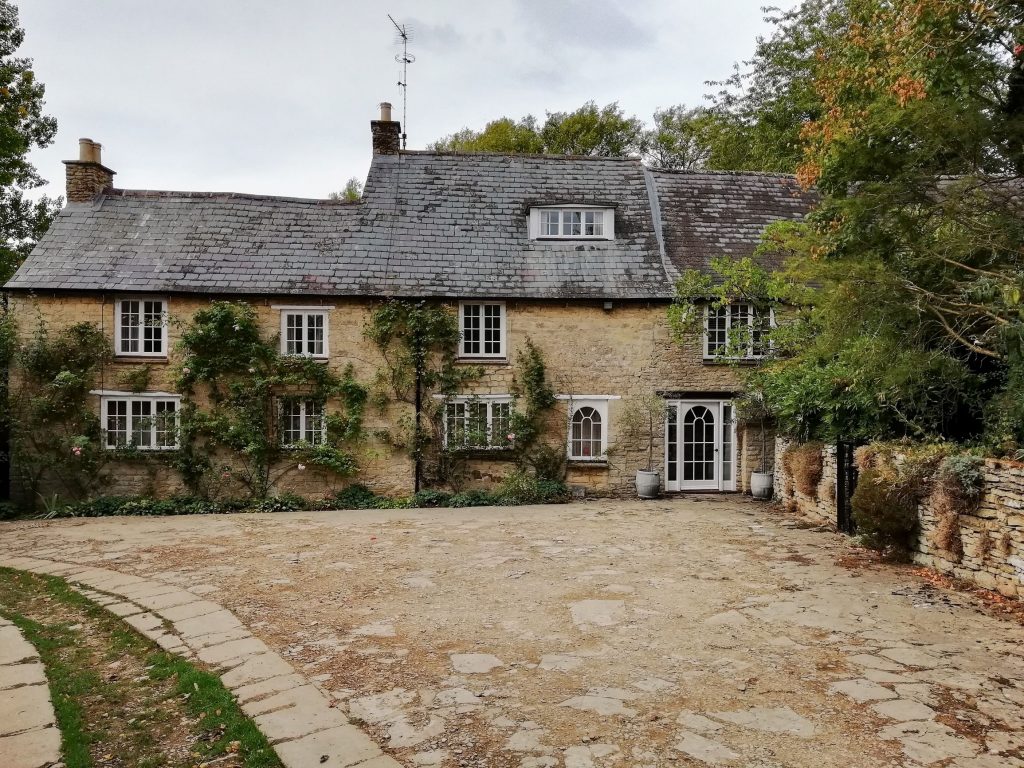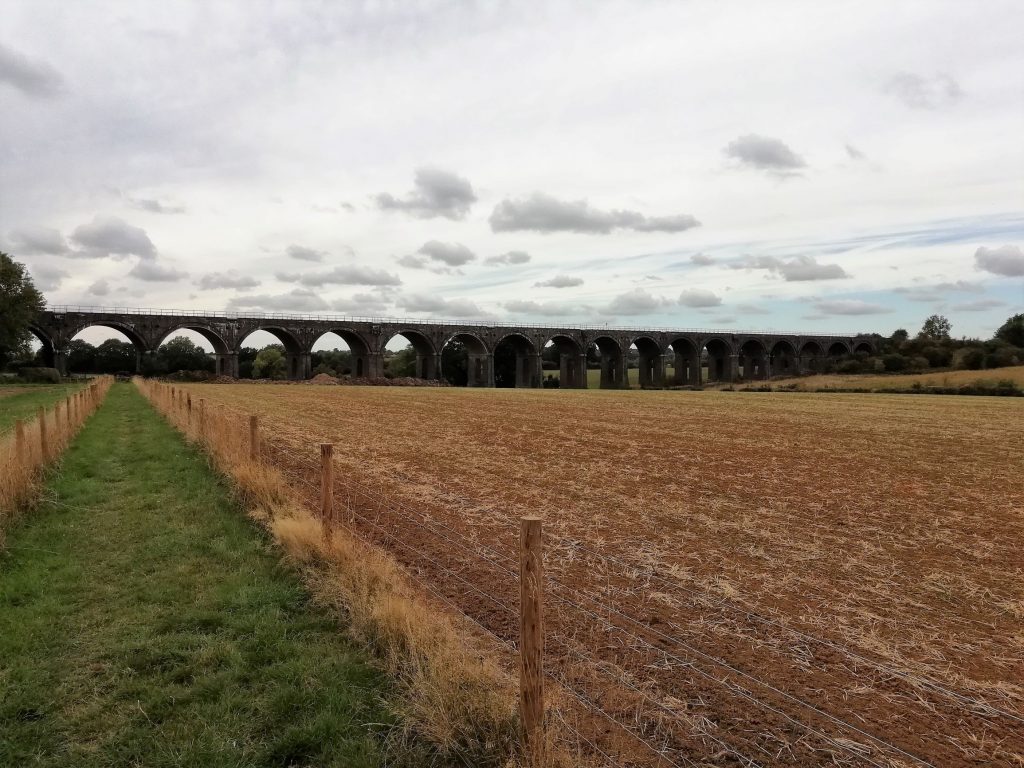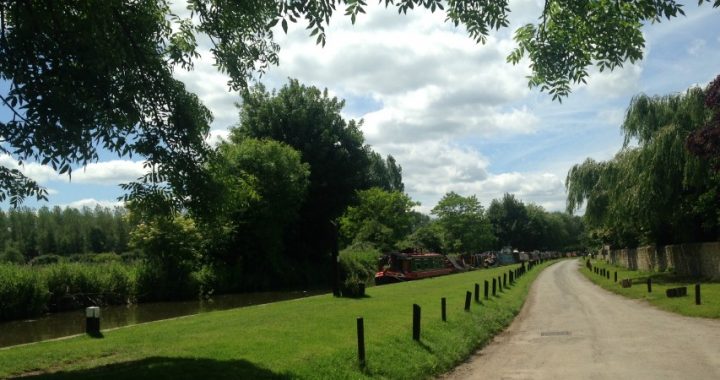Thursday 6th September and with children back at school, their parents safely back at work and some slightly chillier mornings the feeling that summer was drawing to a close was getting stronger. We were rudely awoken before 06:30 by the rattle of sculls on the hull as an early eight skimmed past a fraction too close; amazing how much noise that makes on a steel shell and how long it takes to work out what the hell it is. Still, this morning was to be our last on the Thames and we certainly wouldn’t be troubled by rowing teams on the Oxford Canal.
The Thames continues north from Oxford for a way before veering sharp left and heading west to Lechlade and the source. At the turn is the junction with the Duke’s Cut, dug by order of the 4th Duke of Malborough to provide a link from the Thames to the Oxford Canal, which ended at the Oxford terminus. This created a direct route to London for his Warwickshire coal. At the point where the cut meets the canal the levels could differ very significantly in either direction so the Duke’s Cut Lock was constructed with gates that opened either way, according to which channel’s level was the higher at a given time. Three miles further down the Oxford Canal the two waterways lie very close and the Sheepwash Channel, an unused backwater, was dredged out to provide another route between them that avoided the whole stretch of river up to the Duke’s Cut. It is the latter channel that we planned to follow so we just had to negotiate Osney Lock and the Osney Bridge to be beyond the reach of the EA. At 7′ 6″ this is the lowest bridge on the Thames. Standing on the rear deck I had to duck very low and it must bar access to most of the costly cruisers we have passed on the river.
The change in atmosphere, immediately on turning into the junction, was dramatic. Narrower, hemmed in by trees, meaner housing and commercial premises. It instantly felt darker and gloomier, despite a brilliantly sunny morning. The first thing to strike us was how slowly we were having to move. It is only a very short stretch before you come to CRT’s Isis Lock and the canal proper. It’s astonishing how quickly we had become accustomed to the broad and carefully managed Thames. Where was the lockkeeper? Where were the electronic controls? Most importantly, how were we to manoeuvre our large boat into that tiny, narrow chamber?
Having worked out how to wind the paddles and successfully threaded the needle we carried on up, passing long lines of boats that here, in the narrow confines of the cut, obliged us to slow to tickover from an already snail-like 4 m.p.h. The water here felt shallow and there were new reminders of life on the canal and the way it likes to throw little challenges your way at every turn. CRT workboats were doing some hedge trimming but drifting across the channel in the process, a paddle on the next lock was out of action and by the time we reached Wolvercote Lock we were already pulling over to get down the weed hatch and untangle a skein of nettles and brambles from the propeller shaft.
We hadn’t met many lift bridges in our month on the river but today we had three in the next stretch. The first of these was working well and just reminded us what they were supposed to be about. The second required the user to lift it slightly to catch the point of balance, leap athletically aboard and race to the other side to hang off it to hold it open and then let it down and run across once the boat was through. A couple of boats heading south had already warned us about the third. The lock had just been replaced and also required your full bodyweight to hold the bridge in position to be unlocked. Sue’s newer BWB key wouldn’t turn. My, more worn, copy fitted and turned alright but didn’t release the lock and wouldn’t turn back or come out. Thankfully, after ten minutes struggle, a farm worker who wanted to bring his van across the bridge stopped the other side and came back to help. He had seen them repair the lock the day before, knew it was not fitted correctly and had worked out the knack. Without his help I suspect we would still be there.
By the time we reached the Duke’s Cut junction we had already been going for three and a half hours, it had clouded over and with some way to go before our destination of Thrupp it was time for lunch. When we got going again we had begun to acclimatise, helped by a little bit of familiar fine rain. The pace no longer felt quite so painful, the banks not quite so confining and the challenge of oncoming boats, always at the most inconvenient moments, all part of the fun. Still, no prospect of any U-turns along here, so woe betide the inattentive boater who cruises past the place he is aiming for.
Thrupp starts with a welcoming mooring sign followed, just around the bend, by The Jolly Boatman with more visitor mooring just outside. Having nabbed the one space there for the evening, a stroll further up to the right angle turn at the next Lift Bridge (electronically controlled this time as a public road runs across it) showed that visitor moorings were regularly interspersed with permanent spaces controlled by the mighty TCCC (Thrupp Canal Cruising Club). The TCCC clearly have an iron grip on the whole area, even where the ownership is with CRT. It must be said it all seems to be the better for it. The whole area is clean and tidy. Permanent moorers have not been allowed to set up camps and junk heaps all around their berths. The facilities are clean and maintained, with a warden on site who can be contacted and a notice even offers a mobile phone number for help in finding short term and visitor mooring if you should arrive and find that the official visitor mooring is full. On inspection, while other visitor areas existed, all were occupied and we had the best spot available that night. Eight miles today and we’d almost lost count of the locks and lift bridges, so the hardest day we’d had since entering the Thames. Time for a well-earned refresher at The Jolly Boatman.
Beyond where we were moored, a few lengths along from the pub, the mooring belongs to TCCC as the towpath passes between the canal on one side and fenced small fields and large gardens on the other for about 300 yards. After that and with The Boat just off to the left, the area opens right up for a short terrace of stone cottages facing the canal across a quiet road on the towpath side, followed by a couple of much larger farmhouse properties set well back behind large grounds. On the off side trees give way to open fields and fences so the mooring here is bathed in sunlight most of the day (when the weather is fine). Some of it is 48 hour but a fair section towards the lift bridge is 7 Day. All are free within those restrictions. Having taken a short stroll down here on the following bright, sunny morning I found at least two boat lengths had opened up on the 7 Day section, so cruising on Friday consisted of a short scramble back to the boat to cast off and get down there as quickly as possible. Our final resting place was little short of perfect.
We had intended to stay in Thrupp on Friday, where the 4G signal was excellent, to try and get on with changing both our e-mail addresses on myriad accounts for which they are the user name. As the mooring we had been on was for 48 hours we expected to move again on Saturday morning, with a view to meeting Sue’s brother Phil and his wife Dot and possibly her sister Linda and her husband Alan for lunch on Saturday. We had a slight concern that finding a mooring beyond Thrupp, where they could find us and pick us up by road, might be awkward, especially as rain was forecast for Saturday. Having a 7 Day slot meant we could just stay over a third night and tell them exactly where to collect us.
The weather that Friday was too good to sit indoors changing e-mail all day so we went for a walk to Kidlington and Yarnton. We walked across the fields directly towards St. Mary’s church to arrive at what we assume must have been the original village, very pretty and peaceful in the sunshine as we skirted the churchyard and made our way between paddocks and through a copse around the main town to Mill End. The village was developed along the A4260 to the south in the early part of the 20th century and seems to have filled in from there As we needed a few supplies we headed into what is now the main centre and the modern High Street and shopping centre. This is probably what most people think of as Kidlington today but the original village in the north is well worth a visit.
Thrupp also has a thriving tea shop in Annie’s Tearoom by the lift bridge that had to be sampled in the afternoon and it was then only fair to visit The Boat and give them a chance to compete with The Jolly Boatman for our affections. It was more of a traditional locals pub, it seemed and while nice enough I don’t think I would bother again. One pleasant surprise at both of these establishments was that the price of a round of drinks that we had become accustomed to all along the Thames had instantly dropped by 15-20%.
Saturday proved cool and showery in the morning, as predicted. A good day to stay in and do some of that outstanding admin. We had nothing planned for the day but our lunch out and we were duly collected at 13:00 to head off for Puddingface at the Crown & Tuns in Deddington, where the speciality is pies. The blackboard bears a list of pies on offer that is certainly extensive and covers a wide range from basic Steak & Kidney through to Lamb, Apricot & Moroccan Spices. If you don’t want a pie the offering is meagre and unimaginative in the extreme but why would you come here and then not order a pie? Those we ordered were all delicious and it was a very enjoyable lunch. I am not sure that the nature of these pies would pass Mike Fielding’s very exacting standards, however. By default most of the pies came with puff pastry and in all cases were served as a pastry lid on an earthenware dish of filling both of which would lose marks. On the positive side they were all served as individual pies and came with a separate jug of gravy on the side, which should score well. Perhaps it is the flavour that really counts?
We left Thrupp on Sunday morning which, after a grey and breezy start, brightened up nicely to become a really sunny afternoon. There is a long section of TCCC controlled mooring beyond the bridge in Thrupp and a little public mooring for 14 Days right at the end. As you pass through Shipton Bridge here there is just a single lock gate beyond, with no chamber or paddles, which is chained and padlocked open. There doesn’t seem to be anything different about the canal on one side of the gate or the other so we have no idea what it was for but I am sure someone will enlighten us.
Right the way up until north of Banbury the Oxford Canal runs parallel to and often right alongside the River Cherwell, sometimes only six feet apart with the towpath on a raised bank sandwiched between the two. The Cherwell is no Thames or Severn and it isn’t navigable, as such but it is a substantial river that lends its name to Cherwell Valley, Cherwell District Council and many other local companies and institutions. The philosophy for constructing the Oxford Canal was to avoid difficult and costly engineering, such as tunnels, aqueducts and even locks where possible, by following the contours of the land so this proximity is unsurprising; the Cherwell was probably responsible for forming those contours. At the next lock, Shipton Weir, the canal actually opens into the River Cherwell and you travel along it for a short section. This lock is particularly curious because it is diamond shaped and can accommodate two fairly long boats at once, where most of the other locks are a single boat width and length. There is no explanation as to why this is at the lock and even with a bit of digging no definitive answer. The best suggestion we found was that you have to start controlling the water supply again as you enter the canal downstream from the river. The fall of this lock is quite shallow and the extra width allows it to pass sufficient water downstream to feed the deeper locks there and also to cope with some excess water when the river is in flood.
The next lock, Baker’s Lock, takes you back from the river onto the man-made canal. Just before the lock we began to hear a ruckus amongst the cattle in a field ahead. We came upon a recalcitrant cow that had somehow found a way to position itself on the six inches of canal bank on the wrong side of a pretty new and robust looking barbed wire fence. All its fellows had gathered around the spot to look on from inside the fence and a farmer had just arrived, in a JCB with fork lift attachments, to assess the situation. He clearly couldn’t work out how the cow had got itself outside the fence as, with some exasperation, he got back in the cab and set about using the forks to prise two of the hard-driven fence posts out of the ground and lift the wire to get it back through. What he may have felt he didn’t need was an audience but being a sunny Sunday lunchtime there were plenty of people out on the towpath, no doubt in search of ‘wellbeing’, who gathered in a growing knot of spectators to watch the proceedings. Even a couple of passing boats slowed to a crawl to witness his efforts. The last we saw, as we rounded a bend was the cow, safely back in the field, in a belligerent stand-off with the farmer who, we assume, wanted to examine her for injury. After a couple of approaches had been met with a forward lunge from the cow I think her herdsman felt safe in assuming she was unharmed and walked off in disgust.

Bovine Onlookers
Shortly afterwards we found ourselves moored outside the Rock of Gibraltar in Enslow with a total distance travelled of two miles, having had just one electric lift bridge and the two locks to contend with. There is staging outside the pub, shown on maps as patrons only mooring but everybody was moored on the opposite side. We did go and sample the establishment. It is an interesting layout, with lots of levels and nooks and crannies. It is in desperate need of a good makeover, however, so we could see why, despite it being a sunny Sunday afternoon, the garden was deserted and the pub wasn’t packed with families out for their Sunday lunch.
On Monday we set out for the Heyfords. The three locks en route were no problem and the trip was very uneventful. On the way we passed under Northbrook Bridge 210. This is two bridges, which are now Grade II listed. The old pack horse bridge over the River Cherwell was extended over the canal using the same colour stone so it looks like one structure. This is the furthest point we had previously reached, on a walk from a mooring in Lower Heyford last April, so from here on we were no longer in terra incognita. It is also notable in being a bridge with a public right of way crossing it that is impossible to get up to from the towpath. On our previous trip, on foot, that had meant our planned route didn’t work and we had had to find another way across the canal and back onto the path. Cruising in the opposite direction this time and finding a convenient space just before the bridge at Lower Heyford we decided to stop there, where there is a shop, a café and some services available.
It is time that more attention was called to a 21st Century scourge that should, by now, have been added to the list of those offences against human rights that should be expected to attract the greatest censure. I am referring, of course, to the curse of Internet Deprivation, with which we were afflicted almost as soon as we arrived. Our mobile broadband hotspot device had shown a 4G signal when we tied up but within a few minutes it had dropped to 3G and then nothing at all. Both phones, on different networks, had No Service, Emergency Calls Only. I dug out the SIM from Three that we have as a back-up to O2 and EE but although many continuous cruisers swear by Three, there was no signal there either. We thought for a while that we had Digital TV reception but that too began to break up after about 10 minutes.
It is amazing just how many of the things that you go to do are dependent on some sort of internet connection. Like a lot of things, it is when you realise you don’t have it that you suddenly feel you need it the most. We managed to deal with a couple of things, like Sue’s call to the Doctor’s surgery, by climbing to higher ground at the top of the village. We tried the café at the Wharf for tea but they had no broadband at all. In the end we were forced to visit The Bell and managed to hijack someone’s unsecured wi-fi (it might even have been theirs, it wasn’t obvious though) to get a limited fix over a drink or two before returning, still slightly strung out, to enjoy an unconnected dinner and to dust off the DVD player.
We clearly needed to return to the modern world so we set out fairly early on Tuesday to get to Aynho Wharf, where we planned to spend a couple of nights. There was a lot more traffic today. A couple of Day Boats were out in the mix and quite a lot of hire boats heading towards their mid-week turnover as well as a steady flow of private boats in both directions. We found ourselves queuing at locks and bridges for the first time in many weeks and were generally just behind “Plum Crumble”, a boat out of Cropredy on the first trip out since being re-painted there at great expense to the owners, a nice couple whose names we shall probably never know.
The wind, that had been rising the previous evening, didn’t seem that strong as we left Lower Heyford, which is quite low-lying. From there the canal begins to rise, the land becomes more open and the banks are lined with wire fences rather than hedges so the wind really began to make its presence felt. We had experienced windy days through this section before and the effect on a slab-sided narrowboat can be quite dramatic. It is generally fine as long as you are moving forward but the moment you come to a halt, with no power on the engine, the uncontrollable sideways drift begins, so you really need to tie up to something secure as you reach the side. Several boats we had passed going the other way had issued dire warnings about Somerton Deep Lock as problems with the gate were causing delays. When we arrived there we found we were number four in the queue, which meant the lock landing, with its smooth banks and deeply embedded mooring posts was already full. “Plum Crumble” was hanging on for dear life but had managed to get a line on one of the bollards.
We were left drifting in mid-stream, being blown steadily over to the offside. When we looked back, the Day Boat behind was broadside on and about to go full circle. We had a line ashore but only a two foot wide strip of towpath, behind a bed of tall reeds, to stand on. I could just about hold it but it took the help of a passer-by to actually bring the boat to the side and we managed to secure it to a fencepost. As a boat left the lock we could all move up and we were able to get onto the lock landing. Untying, engaging the engine and securing on the landing before letting the power off required very careful timing and “Plum Crumble”, while being helpful and encouraging us to close up as much as possible couldn’t help casting the occasional anxious glance at his nice new paintwork. The debris that had been blocking the gate had been cleared and passage through the lock was more straightforward after that but there is a clue in the name. At 12 feet, Somerton Deep Lock is one of the deepest in the narrow canal system and so takes some time to fill and empty with each cycle.
Having finally cleared the lock we reached Aynho, where there is 48 hour mooring just before the bridge. The scenario here was much the same. We had to cut the engine because we were right at the bridge and as soon as that happened the wind tried to take the boat. A bit easier here with a wider towpath and fixed rings but a lot of effort to inch her back against the bank until Sue could get off and we could both secure her. A couple of boats immediately behind us left as we were wrestling with this and we were able to move the boat back to a space away from the open fencing into the lee of a thick hedge, which simplified things enormously. All in all it had been quite a hard morning, for us. It was a relief to find that we were once more connected to the outside world and could relax for a late lunch before attending to all those things we hadn’t been able to do on Monday.
There was heavy rain overnight and there were a few showers on and off through the morning so this was a good opportunity to stay in and sort out the last few accounts needing our e-mail addresses changing. The variability in how this is accomplished is astonishing. Some organisations just do it, others require you to jump through several hoops to confirm that you really want to do it and others won’t let you do it yourself at all. Whatever the approach adopted, some of these online processes succeed seamlessly and some fail dismally, in the worst cases changing the account but then refusing to allow access to either the new or the old e-mail address. We were left with those that we had to call in order to change or to fix the mess created. We even had a couple who couldn’t do it at all and just said that if we had to change the e-mail address they would have to close the account altogether and we would have to create a new one. We are not looking forward to going through it all again when we finally get our new home address!
By lunchtime we had had enough and needed some fresh air and exercise. The sky had cleared to leave a bright and mild afternoon so we went out for a circular walk via a nearby village called Souldern, which seemed a nice quiet place with a lot of old houses including a large manor house, a church and little else except a pub and a garage. We didn’t see anyone as we walked around it. No doubt it comes alive when everyone comes back from wherever they go to amass the kind of money required to own a property there. There was an old mill some distance from the village at the bottom of a very long single track lane with concrete strips a wheelbase apart all the way down it. The walk took us past two magnificent railway viaducts, Aynho and Souldern. It also passed under the M40 twice. I am not sure why the huge railway viaducts seemed to be admirable and part of the landscape while the raised motorway came across as an intrusive eyesore.

Souldern Mill

Aynho Viaduct
Back at Aynho we had arranged to meet up with Mike & Lesley Fielding for a meal at the Great Western Arms there. For a Wednesday evening it seemed very busy, with every table we could see reserved and while the dinner service is in full swing it isn’t really a pub for drinking. They found us a table though and we had a really nice meal there. It was nice to catch up on all the news from their ongoing house build and to hear how their boat, Charlie Mo, is performing. The latter was delivered in March from the same boatyard who will be building ours so we are always keen to hear about any snags or pitfalls we should watch out for.


